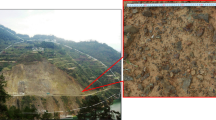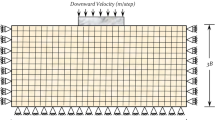Abstract
The soil-rock mixture (SRM) is highly heterogeneous. Before carrying out numerical analysis, a structure model should be generated. A reliable way to obtain such structure is by generating random aggregate structure based on random sequential addition (RSA). The classical RSA is neither efficient nor robust since valid positions to place new inclusions are formulated by trial, which involves repetitive overlapping tests. In this paper, the algorithm of Entrance block between block A and B (EAB) is synergized with background mesh to redesign RSA so that permissible positions to place new inclusions can be predicted, resulting in dramatic improvement in efficiency and robustness.
Similar content being viewed by others
References
Varnes D J. Landslide types and processes. Highway Research Board Special Report, 1958, 29
Selby M J. Hillslope Materials and Processes. Oxford: Oxford University Press, 1982
Nichol D. Landslides and landslide management in south wales. Quarterly J Eng Geol Hydrogeol, 2001, 34: 415–416
Liao Q, Li X, Dong Y. Characteristics and formation mechanism of geological hazards along the section from Nyingchi to Baxoi of the Sichuan-Tibet highway. J Geomech, 2004, 1: 33–39
Ma R, Liang H, Dai S. Experimental study on the deformation characteristics and strength parameters of rock-soil of landslide of levee’s bank slope. In: Proceeding of the 3rd International Conference on Civil Engineering and Urban Planning. Boca Raton: CRC Press, 2014, 177
Zhou J, Cui P, Yang X. Effects of material composition and water content on the mechanical properties of landslide deposits triggered by the wenchuan earthquake. Acta Geol Sin-English Ed, 2016, 90: 242–257
Gao W, Hu R, Oyediran I A, et al. Geomechanical characterization of zhangmu soil-rock mixture deposit. Geotech Geol Eng, 2014, 32: 1329–1338
Larsen K W, Arvidson R E, Jolliff B L, et al. Correspondence and least squares analyses of soil and rock compositions for the Viking Lander 1 and Pathfinder landing sites. J Geophys Res, 2000, 105: 29207–29221
Kokusho T, Hara T, Hiraoka R. Undrained shear strength of granular soils with different particle gradations. J Geotech GeoEnviron Eng, 2004, 130: 621–629
Cao W, Hu T, Luo H, et al. Discussion on a new technique for detecting compactness of soil-rock mixture roadbed. J Hunan Univ, 2008, 2: 22–26
Vallejo L E. Interpretation of the limits in shear strength in binary granular mixtures. Can Geotech J, 2001, 38: 1097–1104
Li X, Liao Q L, He J M. In-situ tests and a stochastic structural model of rock and soil aggregate in the three gorges reservoir area, china. Int J Rock Mech Min Sci, 2004, 41: 702–707
Xu W, Yue Z, Hu R. Study on the mesostructure and mesomechanical characteristics of the soil-rock mixture using digital image processing based finite element method. Int J Rock Mech Min Sci, 2008, 45: 749–762
Fernlund J M R, Zimmerman R W, Kragic D. Influence of volume/mass on grain-size curves and conversion of image-analysis size to sieve size. Eng Geol, 2007, 90: 124–137
Yue Z Q, Chen S, Tham L G. Finite element modeling of geomaterials using digital image processing. Comp Geotech, 2003, 30: 375–397
Wang Y, Zhao M, Li S, et al. Stochastic structural model of rock and soil aggregates by continuum-based discrete element method. Sci China Ser E-Tech Sci, 2005, 48: 95–106
Ng T T. Numerical simulations of granular soil using elliptical particles. Comp Geotech, 1994, 16: 153–169
Ding X L, Li Y X, Wang X. Particle flow modeling mechanical properties of soil and rock mixtures based on digital image. Chin J Rock Mech Eng, 2010, 29: 477–484
Liu Z, Zhou N, Zhang J. Random gravel model and particle flow based numerical biaxial test of solid backfill materials. Int J Min Sci Tech, 2013, 23: 463–467
Yan C, Zheng H. A two-dimensional coupled hydro-mechanical finite-discrete model considering porous media flow for simulating hydraulic fracturing. Int J Rock Mech Min Sci, 2016, 88: 115–128
Yan C, Zheng H. A coupled thermo-mechanical model based on the combined finite-discrete element method for simulating thermal cracking of rock. Int J Rock Mech Min Sci, 2017, 91: 170–178
Ketcham R A, Carlson W D. Acquisition, optimization and interpretation of X-ray computed tomographic imagery: Applications to the geosciences. Comp Geosci, 2001, 27: 381–400
Desrues J, Viggiani G, Besuelle P. Advances in X-ray Tomography for Geomaterials. Wiley Online Library, 2006
Jiang J W, Xiang W, Zhang X Y. Research on mechanical parameters of intact sliding zone soils of Huangtupo landslide based on CT scanning and simulation tests. Chin J Rock Mech Eng, 2011, 30: 1025–1033
Jiang J, Xiang W, Rohn J, et al. Research on mechanical parameters of coarse-grained sliding soil based on CT scanning and numerical tests. Landslides, 2016, 13: 1261–1272
Xu W, Hu R, Yue Z. Development of random mesostructure generating system of soil-rock mixture and study of its mesostructural mechanics based on numerical test. Chin J Rock Mech Eng, 2009, 28: 1652–1665
Wriggers P, Moftah S O. Mesoscale models for concrete: Homogenisation and damage behaviour. Finite Elem Anal Des, 2006, 42: 623–636
Wittmann F H, Roelfstra P E, Sadouki H. Simulation and analysis of composite structures. Mater Sci Eng, 1985, 68: 239–248
Wang Z M, Kwan A K H, Chan H C. Mesoscopic study of concrete I: Generation of random aggregate structure and finite element mesh. Comp Struct, 1999, 70: 533–544
De Schutter G, Taerwe L. Random particle model for concrete based on Delaunay triangulation. Mater Struct, 1993, 26: 67–73
Liu G, Wang Z. Numerical simulation study of fracture of concrete materials using random aggregate model. J Tsinghua Univ, 1996, 36: 84–89
Gao Z, Liu G. Two-dimensional random aggregate structure for concrete. J Tsinghua Univ, 2003, 43: 710–714
Tang X, Zhang C. Simulation of meso-fracture for concrete based on the developed random aggregate model. J Tsinghua Univ, 2008, 48: 348–352
Bažant Z P, Tabbara M R, Kazemi M T, et al. Random particle model for fracture of aggregate or fiber composites. J Eng Mech, 1990, 116: 1686–1705
Talbot J, Schaaf P, Tarjus G. Random sequential addition of hard spheres. Mol Phys, 1991, 72: 1397–1406
Sherwood J D. Packing of spheroids in three-dimensional space by random sequential addition. J Phys A-Math Gen, 1997, 30: L839–L843
Cooper D W. Random-sequential-packing simulations in three dimensions for spheres. Phys Rev A, 1988, 38: 522–524
He H. Computational modelling of particle packing in concrete. Dissertation for Doctoral Degree. Delft: Delft University of Technology, 2010
Sonon B, François B, Massart T J. A unified level set based methodology for fast generation of complex microstructural multi-phase RVEs. Comp Methods Appl Mech Eng, 2012, 223–224: 103–122
Ke T C. Application of DDA to block-in-matrix materials. In: Proceedings of the 35th US Symposium on Rock Mechanics (USRMS). Reno: American Rock Mechanics Association, 1995
Jensen R P, Bosscher P J, Plesha M E, et al. DEM simulation of granular media-structure interface: Effects of surface roughness and particle shape. Int J Numer Anal Meth Geomech, 1999, 23: 531–547
Xu W J, Hu L M, Gao W. Random generation of the meso-structure of a soil-rock mixture and its application in the study of the mechanical behavior in a landslide dam. Int J Rock Mech Min Sci, 2016, 86: 166–178
Wei W, Jiang Q. A modified numerical manifold method for simulation of finite deformation problem. Appl Math Model, 2017, 48: 673–687
Wei W, Jiang Q, Peng J. New rock bolt model and numerical implementation in numerical manifold method. Int J Geomech, 2017, 17: E4016004
Yang Y, Tang X, Zheng H, et al. Three-dimensional fracture propagation with numerical manifold method. Eng Anal Bound Elem, 2016, 72: 65–77
Yang Y T, Tang X H, Zheng H, et al. Hydraulic fracturing modeling using the enriched numerical manifold method. Appl Math Model, 2018, 53: 462–486
Yang Y, Zheng H. A three-node triangular element fitted to numerical manifold method with continuous nodal stress for crack analysis. Eng Fract Mech, 2016, 162: 51–75
Yang Y T, Xu D D, Sun G H, et al. Modeling complex crack problems using the three-node triangular element fitted to numerical manifold method with continuous nodal stress. Sci China Tech Sci, 2017, 60: 1537–1547
Yang Y, Sun G, Zheng H, et al. A four-node quadrilateral element fitted to numerical manifold method with continuous nodal stress for crack analysis. Comp Struct, 2016, 177: 69–82
Yang Y, Zheng H. Direct approach to treatment of contact in numerical manifold method. Int J Geomech, 2017, 17: E4016012
Shi G H, Goodman R E. Two dimensional discontinuous deformation analysis. Int J Numer Anal Methods Geomech, 1985, 9: 541–556
Shi G H. Contact theory. Sci China Tech Sci, 2015, 58: 1450–1496
Ning Y, Yang Z, Wei B, et al. Advances in two-dimensional discontinuous deformation analysis for rock-mass dynamics. Int J Geomech, 2017, 17: E6016001
Shi G H. Discontinuous deformation analysis-a new numerical model for the static and dynamics of block systems. Dissertation for Dcotoral Degree. Berkeley: University of California, 1988
Author information
Authors and Affiliations
Corresponding author
Rights and permissions
About this article
Cite this article
Chen, L., Yang, Y. & Zheng, H. Numerical study of soil-rock mixture: Generation of random aggregate structure. Sci. China Technol. Sci. 61, 359–369 (2018). https://doi.org/10.1007/s11431-017-9136-9
Received:
Accepted:
Published:
Issue Date:
DOI: https://doi.org/10.1007/s11431-017-9136-9




